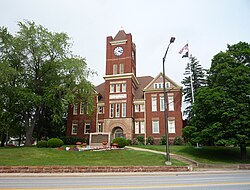Iron Mountain, Michigan | |
|---|---|
| City of Iron Mountain | |
 Iron Mountain City Hall | |
 Location within Dickinson County | |
| Coordinates: 45°49′21″N88°03′51″W / 45.82250°N 88.06417°W | |
| Country | United States |
| State | Michigan |
| County | Dickinson |
| Settled | 1878 |
| Incorporated | 1887 (village) 1889 (city) |
| Government | |
| • Type | Council–manager |
| • Mayor | Dale Alessandrini |
| • Manager | Jordan Stanchina |
| Area | |
• Total | 8.21 sq mi (21.27 km2) |
| • Land | 7.54 sq mi (19.53 km2) |
| • Water | 0.67 sq mi (1.73 km2) |
| Elevation | 1,138 ft (347 m) |
| Population (2020) | |
• Total | 7,518 |
| • Density | 997.08/sq mi (384.97/km2) |
| Time zone | UTC-6 (Central (CST)) |
| • Summer (DST) | UTC-5 (CDT) |
| ZIP code(s) | 49801, 49802, 49831 |
| Area code | 906 |
| FIPS code | 26-40960 [2] |
| GNIS feature ID | 0629079 [3] |
| Website | Official website |
Iron Mountain is a city in and the county seat of Dickinson County, Michigan. The population was 7,518 at the 2020 census, down from 7,624 at the 2010 census. [4] Located in the state's Upper Peninsula, Iron Mountain was named for the valuable iron ore found in the vicinity. [5]
Contents
- Geography
- Demographics
- 2010 census
- 2000 census
- Media
- Newspaper
- Television
- Radio
- Environmental importance
- Menominee Range
- Government
- Transportation
- Bus service
- Major highways
- Airport
- Train
- Notable people
- Climate
- In popular culture
- References
- External links
Iron Mountain is the principal city of the Iron Mountain, MI–WI Micropolitan Statistical Area, which includes all of Dickinson County, Michigan and Florence County in Wisconsin.
Iron Mountain hosts a few points of interest such as the Millie Hill bat cave [6] and the Chapin Mine Steam Pump Engine, and is located adjacent to the Pine Mountain Jump, one of the largest artificial ski jumps in the world. [7] It shares Woodward Avenue with the neighboring town, Kingsford. In addition, Iron Mountain is known for its pasties, [8] bocce ball tournaments, and World Cup ski jumps. Iron Mountain was also named a "Michigan Main Street" community by Michigan governor Jennifer Granholm in 2006. It is one of only thirteen such communities in the state of Michigan in 2008. It is also the hometown of Michigan State University men's basketball coach Tom Izzo and former NFL head coach Steve Mariucci.





